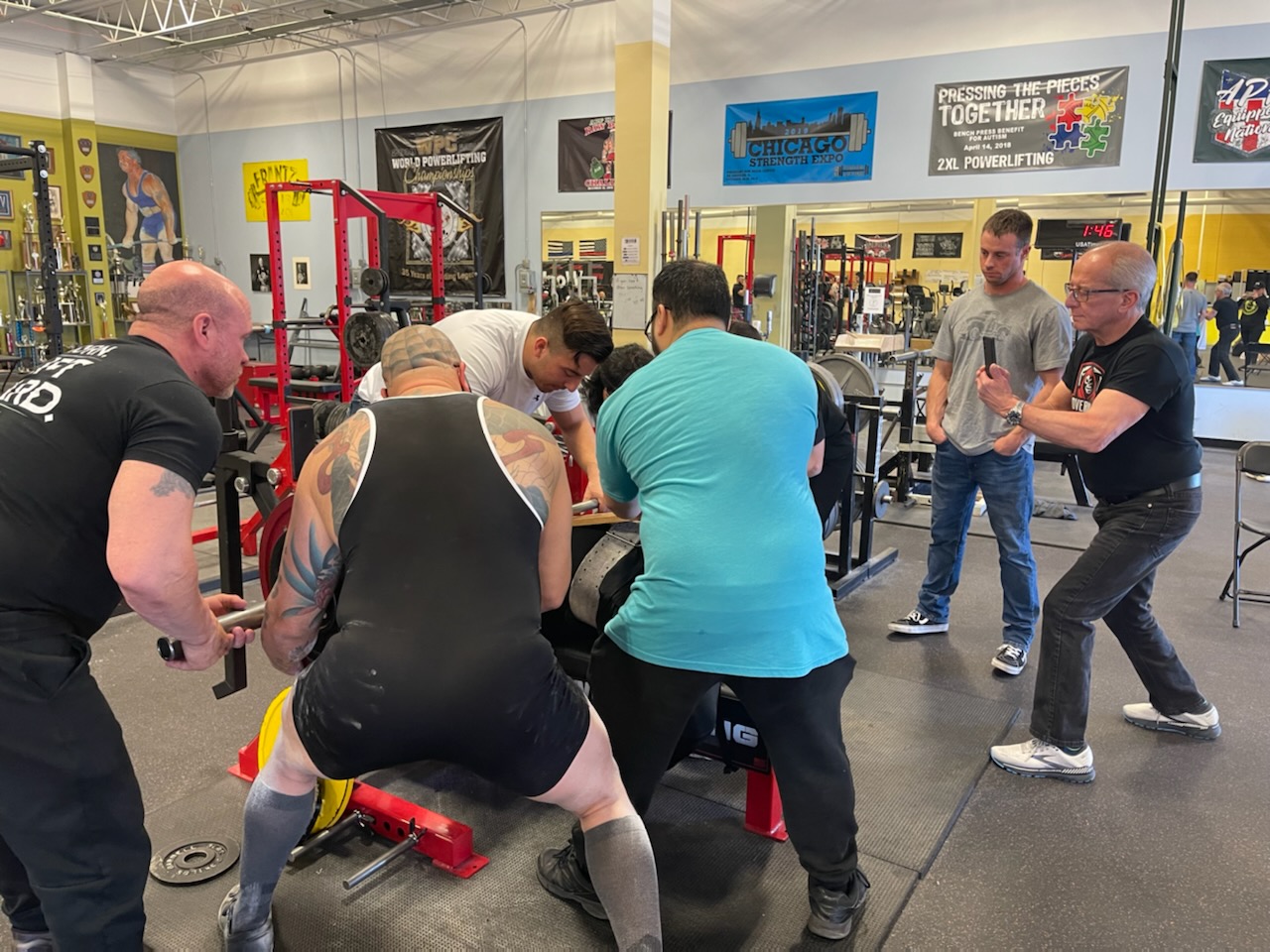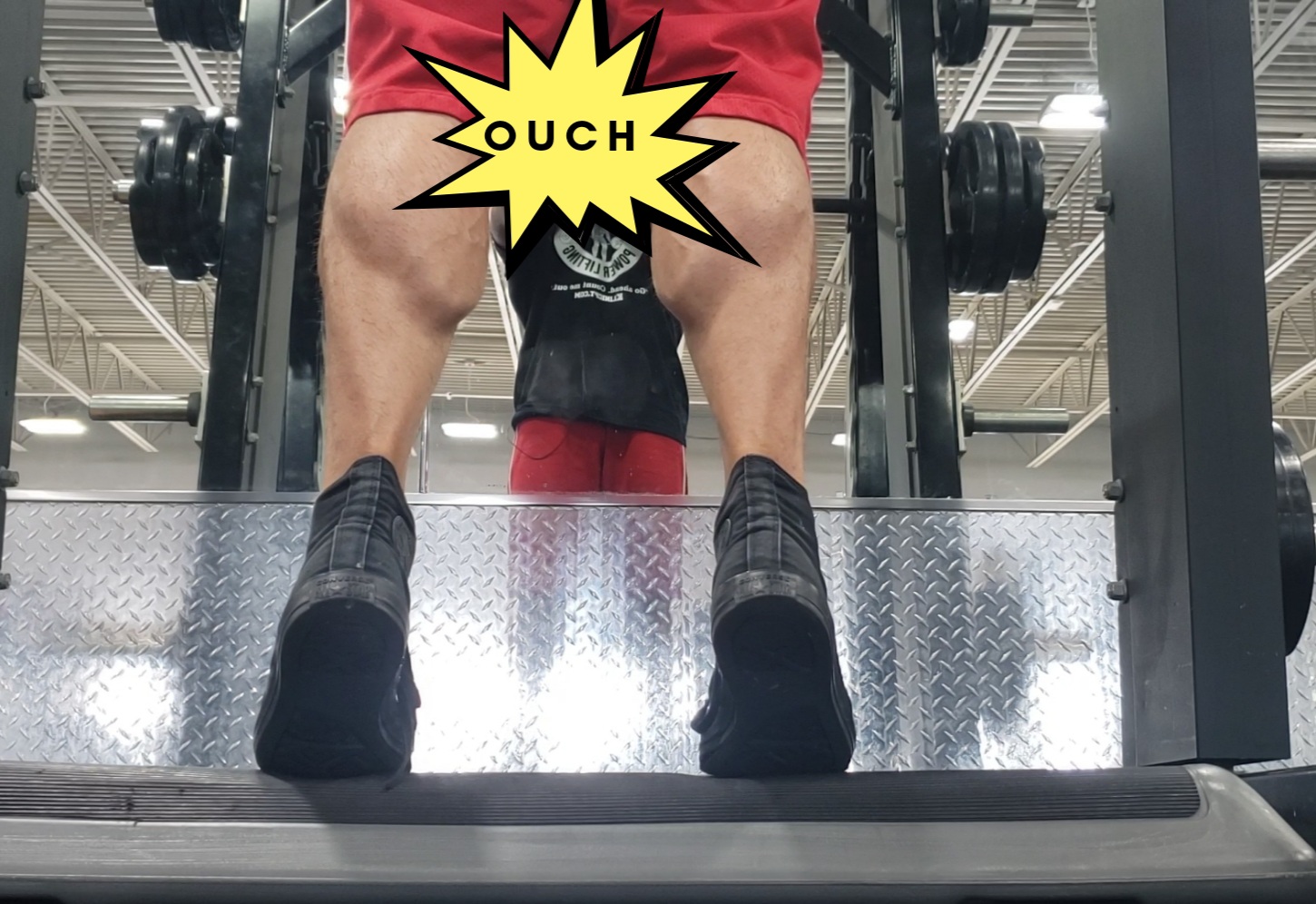If you watch an infant squat down to pick up a toy, pay attention to their immaculate form. Bad habits are learned from laziness, muscle imbalances and injuries. I can walk by someone squatting in the gym, and in my periphery immediately see imperfections: breaking with the knees, the feet collapsing in, chest breathing by shrugging the bar upward, etc.
When I started my comeback from tearing my ACL’s in 2011 I knew my squat form was going to have to be immaculate.
I stayed up some nights visualizing what I could have changed to avoid catastrophe. No way was I ever going to go through this again. In the 2019 WPO, Donnie Thompson narrated the event, and made a comment before I even took a squat, to watch my form. He never met me, but understood my form was going to be textbook because he knew my background.
Top 7 Squat Mistakes
Here are my top 7 squat mistakes beginner to novice lifters make and strategies to correct them. These I have learned from training partners, therapy gurus and my own experience.
1. Squatting wide, toed out all the time.
This goes for warm up sets, heavy days (or as the conjugate guys call, “ME”) and accessory days (“DE”). There are many good coaches who help teach the perfect squat. Dr. Aaron Horschig from Squat University comes to my mind.
Everyone’s mechanics are built differently, so if your coach’s only advice is to “widen you stance, point your toes out,” then you are on a path to an overuse injury down the road. This will include worn out hip joints (ie worn labrum), ITB syndrome, patella tracking issues, TFL syndrome, SI and lumbar pain. Over time gait mechanics deteriorate and powerlifters walk with the “waddle.”
The external rotator hip muscles, lateral quadriceps and quadratus lumborum muscles will be disproportionately stronger than the internal rotators, medial quadriceps, hip adductors and deep spine stabilizers. I treat these overuse syndromes often in my clinic. Although these syndromes are not detrimental, they can become a literal pain in the ass that affects training.
The reason we squat with the “power stance” is it shortens our range of motion, allows us to engage our hips for more power and gives us a larger base of support. For equipped lifters it also increases the load in the briefs and suit.
Tom’s Tip: I save the power stance for my top sets on heavy days. On accessory days I encourage more neutral stance (12:00 position) for toe position and shoulder width.
During a PT exam I always set my patient in the neutral stance to look for hip and knee rotations, spine curvatures and asymmetries. Training with a narrow, toe forward stance will engage neglected muscles during a heavy day: adductors, glute max through extension (not just ER), multifidi (in the back) and even the gastroc.
I often program lunges with a barbell so now the lifter is reduced to only 1 plane (the sagittal plane). Single leg RDL’s also accomplish this task, along with building proprioception. I am a big fan of going raw often because these muscles will be challenged harder, which continues to build our base.
When muscles are balanced, not only is the lifter less prone to injury but he or she will have greater strength! Below is a pic of the 3 planes in which our body moves if you have any interest in physiology or kinesiology.

2 Wrapping the knees too tight, especially on warm-up sets.
Tighter is not always better. You need to be able to feel the quadriceps and gastrocs to control the unrack. Too much tightness inhibits biofeedback (the mind muscle connection), and you will lose your sense of proprioception (joint awareness) with your feet contacting the ground.
If you have tight briefs donned as an equipped lifter would, the quadriceps are already susceptible to going numb. Factor in a wide, toed out stance and now the ACL’s are fully taut. Once a heavy squat load is added, and you do not take the proper steps in pressurizing (#3 mistake) the knees are now very vulnerable to injury.
That is precisely how I tore both my ACL’s in 2011. I have also witnessed this firsthand and have heard of several other similar stories.
Tom’s Tip: I highly recommend taking your warmup sets totally naked or with sleeves if you have some mileage under you.
I have a set of 20-year-old, XSport wraps (sets 315-500lbs), 15 year old TPX wraps (500-800lbs) and Overkills for 800+. Even with the Overkills I start light, and progress in tightness.
During my top set is when I tell my handler to pull tighter. You WILL get more recoil with a tighter wrap, so the risk / reward factor depends on your comfortability.



3 Not pressurizing under the bar.
I learned this the hard way at 28 years old when I attempted to yank 903 in nanosecond off the rack. I was so amped up to make 903 look like a warm-up, that I forgot to pressurize my glutes and hamstrings.
My body had no time to react. Instead, my quadriceps contracted so violently they ruptured my ACL’s. The femur skid forward (anteriorly), tearing my meniscus in the process.
My surgeon at Rush described this injury similarly to a skier skiing down a mogile and then standing up quickly. The only difference is I had more weight on my back.
Now had I steadily pressurized my glutes, hamstrings and quads in a window of roughly two seconds, I could have dispersed the weight transfer safely onto my knees, saving myself a “career ending” injury. (I use quotations because my first doc before Rush said my injury was career ending.)
Tom’s Tip: I imagine myself as a racecar prepared to speed off from the start line. The driver is looking at the lights going from red to green to yellow then takeoff! In the red I am pressurizing with 100lbs. By green I am up to 500 lbs roughly. By yellow I am up to 800 lbs.
And then take off with 900+ lbs. I pressurize through my heels, thinking of my glutes contracting into external rotation.



4 Unracking the bar with your quads versus the glutes.
Watching a lot of newer, raw lifters in the commercial gyms you can see how common this is. But even in powerlifting gyms I notice it because lifters’ knees are too far over their toes. The weight feels safer on the lifter’s back because he or she has a better sense of balance.
Moving the feet forward creates a sense the lifter will fall backward. When someone walks the squat out this pattern is even more common. Why the big deal you ask? Focusing on loading the quadriceps does not cue the posterior chain (ie glutes and hamstrings) to facilitate.
There is a probability the lifter will not be in the most upright position, which during the ascent of the squat the lifter will pitch forward. Furthermore, like I did, a strong quadricep contraction along with poor hamstring control can cause an ACL to tear.
Tom’s Tip: Most lifters unrack in the sagittal plane (like a sheet of plywood splitting us in half symmetrically). They think the lift starts with the knees in front and finish moving backward. Standing to the side of a lifter helps you visualize this movement pattern.
Instead, stand in the front so you are facing the frontal plane (plywood is now turned 90 degrees flush to our face). Visualize the knees going OUT to IN by contracting the glutes. Your knees should still be in line with your feet.
Corey Akers, a friend and IL State Record holder, gave me this cue, and it helped tremendously. Clenching your ass which will cause knee extension through hip external rotation. This takes lots of practice, but if you’ve gone through a quad tear or ACL tear you will see the importance.


5 Good morning the weight up off the rack.
This can happen for numerous reasons, typically someone adjusting from a traditional power rack to the monolift. Someone who has hurt their knee, quad or ACL from squatting may avoid loading their quads. Loading the back feels safer than succumbing the knees to stress.
It took me about four years to regain faith in my reconstructed knees to align my hips under the bar. I was afraid of feeling the “pops” unracking the weight again. In fact, I got goosebumps with 700lbs, 800lbs and then 900lbs (by 1000lbs I felt like a machine lol).
Quadricep weakness may also be a factor. In the therapy world we commonly see patients have difficulty sit to stand. They bend over then straighten up. Over time this reinforces bad mechanics and may lead to low back injury.
Tom’s Tip: This remedy is simpler than the others: practice. Having a good team to zone in and provide constructive feedback is best. Also, perform isolated quadricep and glute strengthening.

6 Squeezing the bar too hard.
The cue some lifters say to bring the elbows under the shoulders – to maintain upright posture – is “bend the bar.” It engages the lat muscles. However, over time “bending the bar” into your back will cause bicep tendinitis.
When the shoulder is put into an external rotation position, along with heavy load applied, the bicep tendon is vulnerable to injury. This is not how you want to go into the bench press during a meet. It may be a short day.
Tom’s Tip: Instead, find the optimal position for the placement of the bar on your back. As you go to stand up, apply just enough pressure to engage the lats through your arms, and just enough grip force to steady the bar.
If you watch a lot of the world’s best multiply squatters, you will notice they leave their pinky finger under the bar and thumb over.
7 Not varying the squat style during accessory days.
Often after a heavy day of squatting or deadlifting our back muscles and CNS are fried. We feel the tightness along our cervical paraspinals all the way down into the lumbosacral junction.
After an overload day on the squat I can literally feel edema running down the parapsinals, which causes my body temperature to elevate and my range of motion becomes restricted. These are indications to back off loading my spine any time soon.
Tom’s Tip: A good way to off load the spine throughout the week is through a belt squat or hack squat (with the padding across the low back). The belt squat has become one of my favorite accessory exercises. I can vary the stances (toe position and foot stance) to facilitate different hip and leg muscles.
It allows me to break parallel and get a good stretch in my rectus femoris. In addition, the belt provides manual overpressure to the lumbar spine to decompress the discs, similar to McKenzie extension mobilizations.
I approach the belt squat the same way as if I was unracking the bar, by swinging my hips under, pressurizing through my heels and squeezing my tush. Brian Carroll relied on the belt squat in his pursuit of the 1300lb barrier. The hack squat is a tier down from the belt squat, because it forces our hips into a set position.

If you have ever been injured squatting, require professional advice or are interested in manual therapy from overuse, contact me.
Are you interested in a specific squatting program to boost your max raw or multiply? I can help. Keep an eye out in future blog contents for Tom’s Tip for the Perfect Knee Wrap and insight from some of the top squatters.





2 Responses